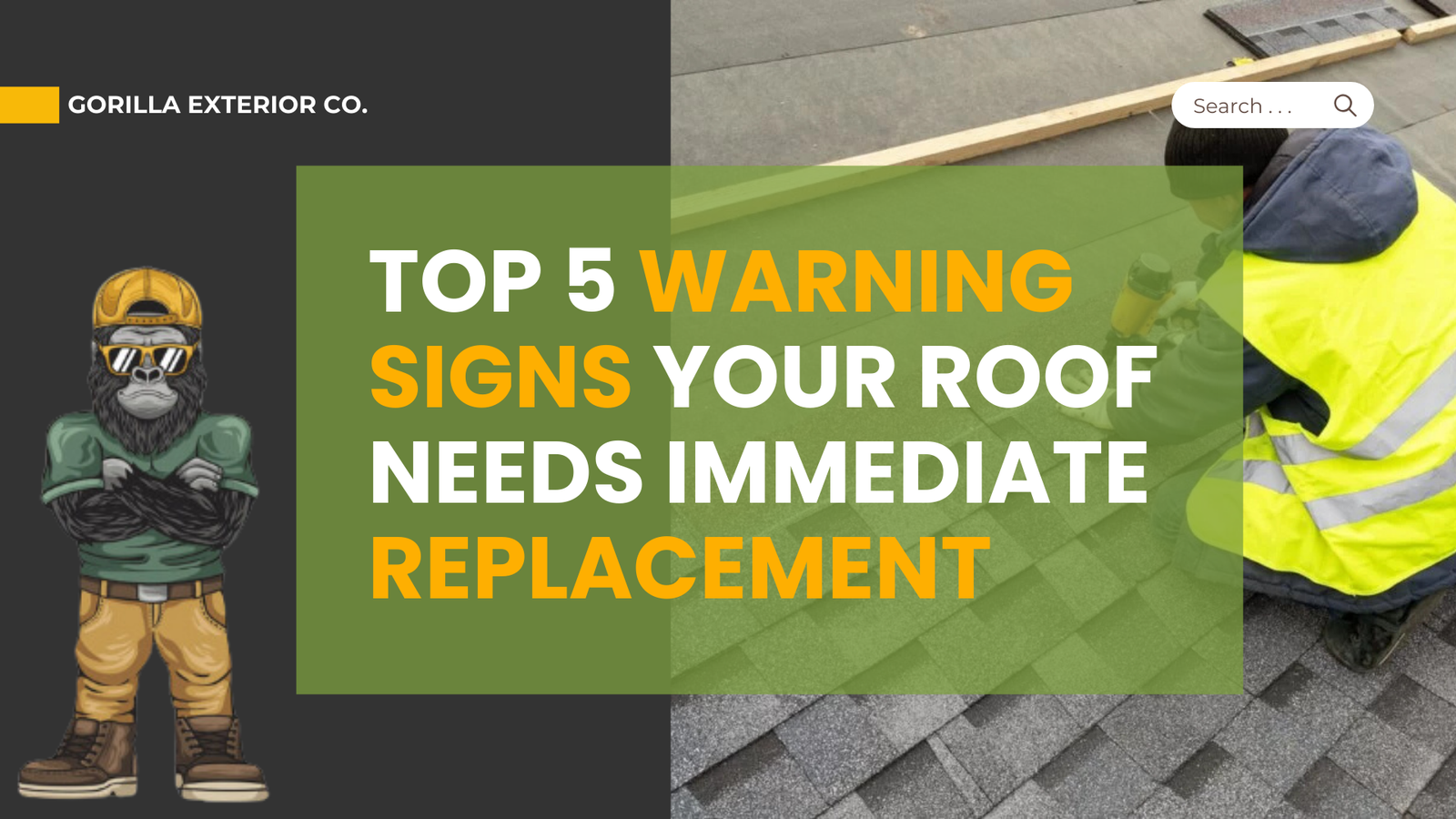Warning Signs Your Roof Needs Immediate Replacement
Your roof is one of the most important parts of your home, protecting you and your family from the elements year-round. However, roofs can deteriorate over time and knowing when to replace yours is critical to avoid costly damage. At Gorilla Exterior Co., we specialize in roof replacements and want to help you identify the early warning signs before it’s too late. Here are the top five indicators that your roof may need immediate replacement.
Visible Roof Damage
1. Curling or Missing Shingles
Shingles are the primary protective layer of your roof, and when they start to curl or go missing, your roof’s effectiveness is compromised. Curling can result from weather exposure or improper installation, while missing shingles expose your roof to leaks and other damage. If you spot large sections of curling or missing shingles, it’s a red flag that your roof may be at the end of its lifespan.
What to do: If you notice curling or missing shingles, it’s time to contact a professional for a roof inspection. They can assess the extent of the damage and determine if repairs are possible or if a full roof replacement is needed.
Check our blog post about: Shingle roofing vs Metal roofing
2. Leaks Inside Your Home
One of the most obvious signs that your roof is failing is water leaking inside your home. This could manifest as water stains on your ceiling, moisture in your attic, or visible drips during rain. Roof leaks can lead to mold growth, structural damage, and other costly repairs if left unchecked.
What to do: Leaks suggest that your roof’s protective barrier has been breached. Don’t wait until the damage worsens—schedule a roof inspection right away with Gorilla Exterior Co. We can assess the issue and recommend the best course of action to keep your home safe from water damage.
3. Sagging Roof Deck
A sagging roof deck is a serious concern and often indicates moisture damage that has penetrated the roofing materials into the decking. This could result from prolonged exposure to water due to leaks or improper ventilation. A sagging roof not only compromises the structural integrity of your home but also poses a significant safety risk, as it could eventually collapse.
What to do: If you notice any part of your roof sagging, call a roofing professional immediately. This type of damage typically requires a full roof replacement to restore the structure’s integrity and prevent further hazards.
4. Granules in Your Gutters
Roofing shingles are coated with granules to provide protection from the sun and weather. As shingles age, these granules begin to wear away, often ending up in your gutters. If you start seeing granules that resemble coarse, black sand in your gutters or around your downspouts, it’s a sign that your roof may be nearing the end of its useful life.
What to do: The presence of significant amounts of granules in your gutters is a clear indication that your shingles are deteriorating. Have your roof inspected to see if a replacement is necessary before further damage occurs.
5. Roof Age
Roofs have a finite lifespan, and the age of your roof is a major factor in determining whether it needs replacement. Different roofing materials last for varying lengths of time, and understanding the typical lifespan of your roof material can help you plan for when a replacement is necessary.
Here are the average lifespans for different types of roofing materials:
- Asphalt-shingle roofs: 20–30 years
- Metal roofs: 50–80 years
- Composite (synthetic) shingles: 40–50 years
- Cedar shake roof: 30 years if properly installed and maintained
- Slate roof: 75–100 years
- Fiber cement shingles: 25 years
- Clay tile roofs: 50–60 years, with the potential to last 100+ years
- Concrete roofs: 30–60 years, with the potential to last 75+ years
If your roof is approaching or exceeding the upper range of its expected lifespan, even if it’s not showing obvious signs of damage, it’s time to consider a replacement.
Several other factors can influence a roof’s lifespan:
- Installation: A properly installed roof lasts longer. Poor installation can result in premature failure.
- Maintenance: Regular maintenance, such as clearing debris and addressing minor issues, can help extend your roof’s lifespan.
- Climate: Harsh winters, hot summers, or frequent storms can shorten the life of a roof.
- Location: Factors like shade from trees and exposure to sunlight affect the longevity of your roof.
- Color: Darker roofing materials absorb more heat, which can reduce the roof’s lifespan.
- Roof slope: Steeper roofs allow moisture to run off more easily, which helps the roof last longer.
- Multiple layers: If a new roof is installed over an old one, its lifespan is often shortened.
- Attic ventilation: Proper attic ventilation helps extend the life of your roof by preventing heat and moisture buildup.
- Trees: Overhanging branches or leaf debris from nearby trees can damage roofing materials and reduce their lifespan.
By understanding the material and age of your roof, you can anticipate when a replacement may be necessary and avoid costly surprises. A professional Roof inspection by Gorilla Exterior Co. can give you the peace of mind that your roof is still performing as it should.
Don’t Wait for Roof Trouble to Escalate Call Roofing Contractors in Denver, PA!
Your roof is essential to protecting your home, and knowing the warning signs of roof failure can help you avoid costly repairs or emergencies. If you’ve noticed any of the signs mentioned in this blog, don’t wait—contact Gorilla Exterior Co. for a free inspection. Our team of roofing experts in Denver, PA will assess your roof and provide a detailed recommendation for repair or replacement, ensuring your home is safe and secure.
